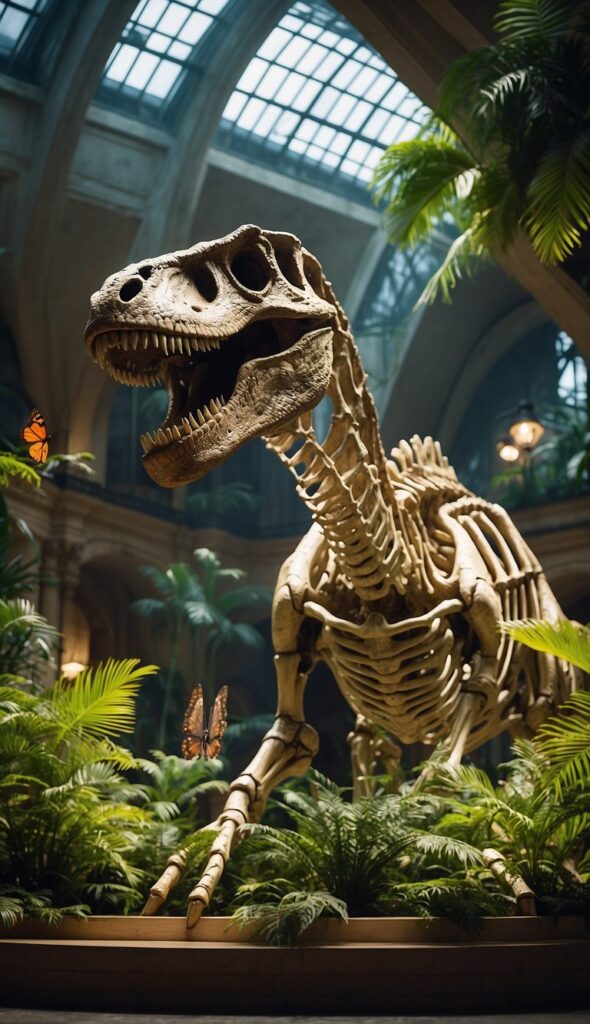Nestled in the heart of Philadelphia’s historic Logan Square neighborhood, the Academy of Natural Sciences of Drexel University stands as a beacon of scientific discovery and educational excellence. Situated within the Parkway Museums District, this iconic institution has been captivating visitors for over two centuries with its fascinating exhibits, diverse collections, and groundbreaking research initiatives.
Surrounded by a rich tapestry of cultural landmarks and green spaces, the Academy offers a gateway to exploration unlike any other. Just steps away, visitors can immerse themselves in the artistic masterpieces of the Philadelphia Museum of Art or embark on a journey through history at the Franklin Institute Science Museum. For those seeking a tranquil escape, the lush landscapes of Fairmount Park beckon with miles of scenic trails, serene waterways, and picturesque picnic spots.
Amidst the hustle and bustle of urban life, the Academy serves as a sanctuary for nature enthusiasts and science lovers alike. From towering dinosaur skeletons to vibrant displays showcasing the wonders of biodiversity, the institution invites visitors to marvel at the beauty and complexity of the natural world. With its prime location and immersive exhibits, the Academy offers an unparalleled opportunity to connect with nature and gain a deeper understanding of our planet’s ecosystems.
Whether you’re a lifelong learner, a curious explorer, or simply seeking inspiration amidst Philadelphia’s cultural treasures, a visit to the Academy of Natural Sciences promises an unforgettable experience. Join us as we embark on a journey of discovery, where science meets wonder and adventure awaits around every corner.
Table of Contents
Historical Legacy
The Academy of Natural Sciences of Drexel University boasts a rich historical legacy that dates back to its founding in 1812, making it one of the oldest institutions of its kind in the Western Hemisphere. Born out of the vision of a group of prominent naturalists and scientists, including the likes of Thomas Jefferson and John James Audubon, the Academy was established with the lofty goal of advancing the study of the natural world and promoting scientific knowledge.
From its humble beginnings as a small collection housed in Independence Hall, the Academy quickly grew in stature and influence, attracting renowned scientists and scholars from around the world. Throughout the 19th century, the institution played a pivotal role in documenting and cataloging the vast biodiversity of the American continent, spearheading expeditions to remote corners of the globe in search of new species and geological wonders.
Over the years, the Academy’s collections expanded exponentially, encompassing millions of specimens ranging from fossils and minerals to plants and animals. These invaluable treasures not only served as a vital resource for scientific research but also captured the imagination of generations of visitors, inspiring a deeper appreciation for the wonders of nature and the importance of conservation.
In 2011, the Academy entered a new chapter in its storied history with its integration into Drexel University, further solidifying its position as a leading center for scientific inquiry and education. Today, as it continues to build upon its legacy of excellence, the Academy remains dedicated to advancing our understanding of the natural world, preserving Earth’s biodiversity, and inspiring future generations of scientists and conservationists.
Diverse Collections
The Academy of Natural Sciences of Drexel University boasts a treasure trove of diverse collections that span millions of specimens, providing a window into the rich tapestry of life on Earth. From ancient fossils to vibrant botanical specimens, these collections offer a fascinating glimpse into the wonders of nature and the ever-evolving story of biodiversity.
- Fossil Collection: The Academy’s fossil collection is a testament to the Earth’s prehistoric past, housing an impressive array of ancient specimens that span millions of years of evolution. From towering dinosaur skeletons to exquisite fossilized plants, these artifacts offer invaluable insights into the history of life on our planet and the processes that have shaped it over time.
- Botanical Collection: Encompassing a diverse array of plant specimens from around the world, the Academy’s botanical collection showcases the stunning beauty and remarkable diversity of the plant kingdom. With specimens ranging from delicate flowers to towering trees, this collection provides a comprehensive overview of plant life and serves as a vital resource for botanical research and education.
- Mineral Collection: The Academy’s mineral collection features a dazzling array of geological specimens, including rare crystals, colorful gemstones, and unique rock formations. From sparkling quartz crystals to intricate mineral formations, these specimens offer a glimpse into the Earth’s geological processes and the incredible diversity of minerals found beneath its surface.
- Bird Collection: With over 200,000 specimens representing thousands of species from around the world, the Academy’s bird collection is one of the largest and most comprehensive in the country. From brightly colored songbirds to majestic birds of prey, these specimens provide valuable insights into avian diversity, behavior, and evolution.
- Mammal Collection: The Academy’s mammal collection boasts a diverse array of specimens representing mammals from every corner of the globe. From the smallest rodents to the largest land mammals, these specimens offer a fascinating glimpse into the diversity of mammalian life and the adaptations that have allowed these creatures to thrive in their respective environments.
- Insect Collection: Home to millions of specimens representing thousands of insect species, the Academy’s insect collection is a treasure trove of biodiversity. From dazzling butterflies to formidable beetles, these specimens offer a fascinating glimpse into the world of insects and their crucial role in ecosystems around the world.
- Herpetology Collection: The Academy’s herpetology collection is one of the largest and most comprehensive in the world, housing thousands of specimens representing reptiles and amphibians from every corner of the globe. From slithering snakes to hopping frogs, these specimens provide valuable insights into the diversity, distribution, and conservation status of these often misunderstood creatures.
Research and Conservation
Research and conservation lie at the heart of the Academy of Natural Sciences of Drexel University’s mission, driving its commitment to scientific excellence and environmental stewardship. Through pioneering research initiatives and collaborative partnerships, the Academy seeks to unravel the mysteries of the natural world while advocating for the preservation of Earth’s precious ecosystems.
With a team of dedicated scientists and experts spanning various disciplines, the Academy conducts cutting-edge research across the globe, tackling pressing issues such as climate change, habitat loss, and species extinction. From studying urban wildlife in Philadelphia to exploring remote rainforests in the Amazon, researchers at the Academy are at the forefront of efforts to better understand the complex interactions between humans and the environment.
One of the hallmarks of the Academy’s research program is its emphasis on interdisciplinary collaboration, bringing together experts from diverse fields to tackle complex environmental challenges. By leveraging the latest technologies and methodologies, researchers at the Academy are able to generate innovative solutions to pressing conservation issues, paving the way for informed decision-making and sustainable resource management.
In addition to its research efforts, the Academy is actively involved in conservation initiatives aimed at protecting endangered species and fragile habitats. Through fieldwork, education programs, and advocacy efforts, the institution works tirelessly to raise awareness about the importance of biodiversity conservation and empower communities to take action to safeguard their natural heritage.
As we confront the unprecedented challenges posed by climate change and biodiversity loss, the work of the Academy of Natural Sciences of Drexel University has never been more crucial. By advancing scientific knowledge, fostering collaboration, and promoting environmental stewardship, the Academy is helping to shape a more sustainable future for generations to come.
Education and Outreach
Education and outreach are integral components of the Academy of Natural Sciences of Drexel University’s mission, serving as catalysts for inspiring curiosity, fostering understanding, and promoting conservation of the natural world. Through a diverse array of programs and initiatives, the Academy engages learners of all ages, backgrounds, and interests, empowering them to become informed stewards of the environment.
At the heart of the Academy’s educational efforts are its immersive exhibits and interactive displays, which offer visitors a captivating journey through the wonders of nature. From towering dinosaur skeletons to vibrant dioramas showcasing diverse ecosystems, these exhibits provide a hands-on learning experience that sparks curiosity and ignites a passion for discovery.
In addition to its on-site offerings, the Academy extends its educational reach through a variety of outreach programs designed to engage communities both locally and globally. From school programs and summer camps to teacher workshops and citizen science projects, these initiatives provide opportunities for learners of all ages to explore science in action and connect with experts in the field.
Central to the Academy’s educational philosophy is a commitment to fostering a sense of environmental responsibility and promoting sustainability. Through initiatives such as green practices in museum operations, community gardening projects, and educational programs focused on conservation, the Academy strives to instill in visitors a deeper appreciation for the interconnectedness of all living things and the importance of preserving Earth’s biodiversity.
By serving as a hub for learning, discovery, and engagement, the Academy of Natural Sciences of Drexel University plays a vital role in shaping the next generation of scientists, educators, and conservationists. Through its innovative educational programs and commitment to outreach, the Academy continues to inspire curiosity, ignite imaginations, and empower individuals to make a positive difference in the world around them.
Conclusion
In conclusion, the Academy of Natural Sciences of Drexel University stands as a beacon of discovery, education, and conservation in the heart of Philadelphia. Through its rich history, diverse collections, and groundbreaking research initiatives, the Academy has remained at the forefront of scientific inquiry for over two centuries, inspiring generations of visitors to marvel at the wonders of the natural world. As we navigate the complex challenges of the 21st century, from climate change to habitat destruction, the work of the Academy has never been more important. By fostering a deeper understanding of the interconnectedness of life on Earth and promoting environmental stewardship, the institution continues to play a vital role in shaping a more sustainable future for our planet and all its inhabitants.
Whether you’re a curious explorer, a passionate scientist, or simply an admirer of the beauty and diversity of nature, a visit to the Academy of Natural Sciences promises an unforgettable experience. As you wander through its halls, surrounded by towering dinosaur skeletons, dazzling gemstones, and vibrant botanical specimens, you’ll be reminded of the incredible complexity and resilience of life on Earth. So come, join us on a journey of discovery, where every exhibit, every specimen, and every discovery serves as a testament to the enduring power of scientific inquiry and the awe-inspiring beauty of the natural world.





